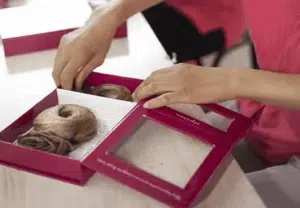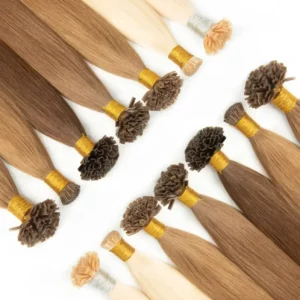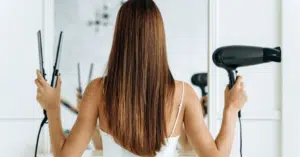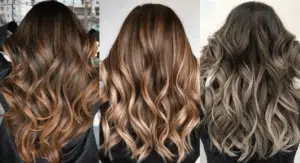Choosing the right hair extension material is crucial for your clients’ satisfaction and your business’s success. Using inferior materials leads to tangling, shedding, and unhappy customers, while selecting premium-grade hair boosts your brand reputation and profitability.
The top material in today’s market is full cuticle human hair — a luxury-grade raw material known for its durability, softness, and natural appearance.
This guide covers all major hair extension materials, explains why full cuticle hair stands apart, and helps you select the ideal product to meet your clients’ and business’s needs.
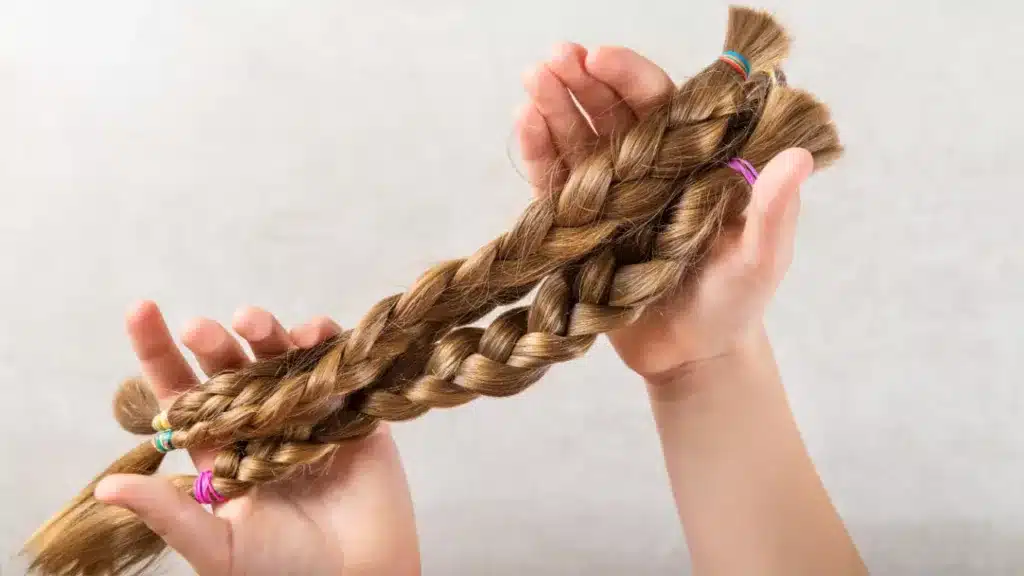
What Are Hair Extensions Made Of?
Hair extensions are generally made from either synthetic fibers or human hair — each with distinct qualities that impact styling, longevity, and client experience.
Synthetic Hair
Synthetic fibers like Kanekalon or Toyokalon are inexpensive alternatives.
- Advantages: Affordable, colorfast, and low maintenance.
- Disadvantages: Cannot be heat-styled, prone to tangling, unnatural texture and shine.
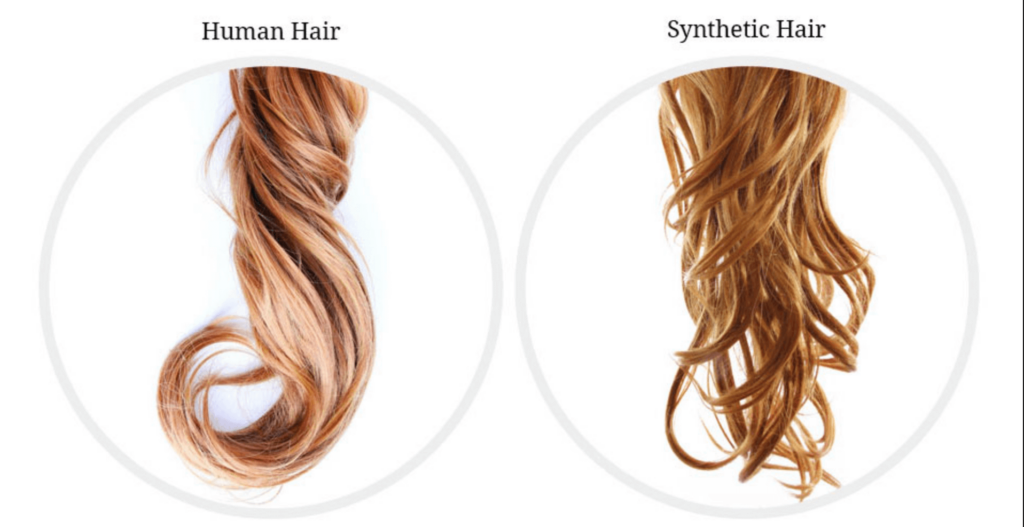
Human Hair Grades
Human hair extensions offer a natural look and feel, but quality varies widely:
| Grade | Description | Advantages | Disadvantages |
|---|---|---|---|
| Full Cuticle Hair | 100% cuticles intact and aligned, usually from a single donor | Long-lasting, soft, tangle-free | Higher cost, limited supply |
| Remy Hair | Cuticles mostly aligned but may be chemically processed | Natural look, good durability | Slightly shorter lifespan |
| Non-Remy Hair | Cuticles misaligned or stripped | Low price | Tangling, rough texture, short lifespan |
What Are Full Cuticle Hair Extensions?
Full cuticle hair extensions represent the gold standard in luxury hair products. They are crafted from 100% high-quality human hair with the cuticle layer fully preserved and aligned in the same direction — root to tip.
This preservation maintains the hair’s natural texture, shine, and strength, resulting in extensions that last 12-18 tmonths with proper care. Unlike chemically processed or cuticle-stripped hair, full cuticle extensions retain a healthy, authentic look.
Why Does Cuticle Preservation Matter?
The cuticle is the hair’s protective outer layer made of overlapping scales. When cuticles remain intact and aligned, hair resists tangling, shedding, and damage. Conversely, damaged or misaligned cuticles cause rough texture, increased matting, and shorter lifespan.
Advantages of Full Cuticle Hair Extensions
- Natural Shine & Authentic Look
The intact cuticles reflect light beautifully, creating a healthy, radiant appearance that looks and feels like natural hair. - Strength & Durability
Unprocessed and untreated, the hair is in its strongest state, resisting breakage and wear. Properly maintained, these extensions can last over a year, offering excellent value. - Tangle-Free & Low Shedding
Uniform cuticle alignment prevents tangling and minimizes shedding, ensuring a smooth, manageable experience for the wearer. - Reduced After-Sales Issues
For wholesalers and stylists, high-quality full cuticle hair means fewer customer complaints and returns, saving time and enhancing brand reputation.

Types of Full Cuticle Hair Extensions
Full cuticle hair extensions come in multiple forms to suit various styling preferences and client needs.
1. Full Cuticle Tape-In Hair Extensions
Tape-in extensions are thin wefts attached to natural hair with medical-grade adhesive tape. They offer seamless blends with natural shine and are quick to install (1–2 hours).
- Variants: Regular Tape, Invisible Tape, Flower Tape, Slim Tape.
- Durability: Last 6–8 weeks before reinstallation; reusable with fresh tape.
- Best For: Clients wanting semi-permanent, lightweight, natural-looking extensions.
TAPE IN HAIR
2. Full Cuticle Hair Wefts
Wefts are rows of hair sewn or bonded onto tracks, ideal for sew-ins or micro-link methods.
- Variants: Machine Wefts, Hand-Tied Wefts, Genius Wefts, Flat Wefts, Butterfly Wefts, Feather Wefts.
- Durability: Can last several months with proper care.
- Best For: Clients seeking secure, long-term volume and length, especially those with thicker hair.
HAIR WEFT
3. Full Cuticle Clip-In Hair Extensions
Clip-ins offer a temporary, flexible solution with small clips attached to hair sections for easy home application.
- Variants: Classic Clip-Ins, Invisible Clip-Ins, Lace Clip-Ins.
- Durability: Long-lasting if cared for; more durable than synthetic alternatives.
- Best For: Clients desiring styling flexibility or short-term use for special occasions.
CLIP IN HAIR
4. Full Cuticle Keratin Bond Hair Extensions
Keratin bond extensions use heat to fuse individual strands tipped with keratin to natural hair, creating strong, nearly invisible bonds.
- Variants: Flat Tip, U-Tip, V-Tip.
- Durability: Last 3–5 months with maintenance.
- Best For: Clients wanting discreet, long-lasting extensions suitable for varied hairstyles.
KERATIN HAIR
5. Full Cuticle Micro-Link Hair Extensions
Micro-link (or micro-bead) extensions attach strands to natural hair with small silicone or metal beads, requiring no heat or glue.
- Variants: I-Tip, Micro Ring, Nano Ring.
- Durability: Last 3–4 months; beads need tightening as hair grows.
- Best For: Clients seeking a glue-free, heat-free method with natural movement.
KERATIN HAIR
My Opinion
After 25 years producing full cuticle hair extensions, Hibiscus Hair knows that full cuticle hair is the only material worthy of professional salons and premium brands. It ensures longevity, natural beauty, and client satisfaction, which no synthetic or lower-grade hair can match.
FAQ
Q: What is the best hair to use for extensions?
A: Full cuticle human hair — it delivers superior durability and natural aesthetics.
Q: How long does full cuticle hair last?
A: 12 to 18 months with proper care.
Q: Can synthetic hair be used for premium clients?
A: No, it lacks styling versatility and natural appearance.
Q: Why is full cuticle hair more expensive?
A: It requires ethical sourcing, careful processing, and is rare.
Q: Can hair grades be mixed to reduce costs?
A: Yes, but this compromises quality and lifespan.
Q: Is full cuticle hair color-safe?
A: Yes, but coloring should be done professionally to protect cuticles.
Q: Which extension type suits fine hair best?
A: Hand-tied wefts or single-sided tape extensions reduce bulk.
Q: Do keratin tips damage natural hair?
A: No, if installed and removed correctly by professionals.
Q: How should full cuticle hair extensions be stored?
A: In a cool, dry place inside breathable storage bags.
Q: How often should tape-in extensions be replaced?
A: Every 6–8 weeks.
Q: Can clients swim with extensions?
A: Yes, but rinse hair immediately after and use leave-in conditioner.
Q: Which installs faster, tape or keratin?
A: Tape-in extensions are generally quicker to install.
Q: Which extension type yields better salon profitability?
A: Full cuticle hair in reusable formats like tape-ins or clip-ins offers higher ROI.

Conclusion
For salons and brands targeting luxury, durability, and client satisfaction, full cuticle human hair is the superior material. Combining this with the right extension method will elevate your offerings, reduce after-sales issues, and grow your business with loyal customers.
Hibiscus Hair Manufacturer has specialized in full cuticle hair extensions for 25 years and leads the industry in quality and innovation. Contact us to learn more about our production process and premium products.
QUALITY

